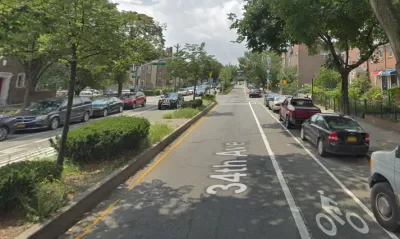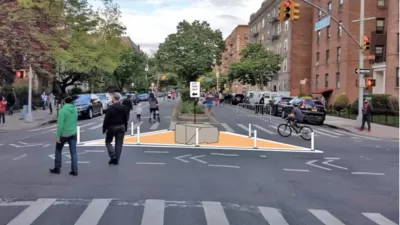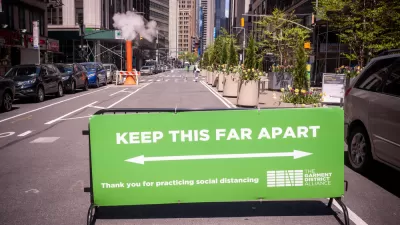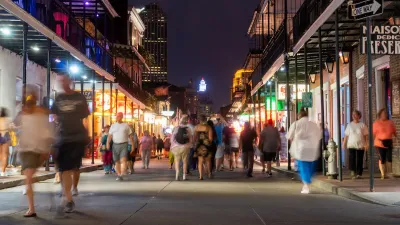A debate over one Queens 'open street' project illustrates the challenges of maintaining open streets.

Each day at 8 a.m., New York's 34th Avenue becomes off-limit to cars (with some exceptions). As Winnie Hu details in the New York Times, this 26-blocks stretch anchors a network of dozens of miles of open streets across the city that was created in response to the outbreak and provides a tantalizing glimpse of a future of traffic-free streets."
But "a push to make 34th Avenue into a 'linear park,' where cars would be permanently restricted, has provoked a backlash from some residents and drivers over what they see as an experiment gone too far," causing gridlock and making it "harder to find parking and get deliveries and services in a neighborhood where many depend on cars." A resident group called 34 Compromise seeks to scale back the open street program, in part by reducing the hours.
In New York City, "[t]he streets make up about 27 percent of the city’s total land area." According to urban planner Mike Lydon, "[p]rogramming them so they are not just mobility corridors is absolutely a lesson of the pandemic" and should remain at the heart of planning policy. 34th Avenue now plays host to social events, picnics, and performances that could continue to connect neighbors well beyond the pandemic. "[T]he battle over 34th Avenue goes beyond whether cars or people should have priority to a debate over how an open street adds to — or detracts from — a neighborhood’s rhythms."
FULL STORY: The Pandemic Gave New York City ‘Open Streets.’ Will They Survive?

Alabama: Trump Terminates Settlements for Black Communities Harmed By Raw Sewage
Trump deemed the landmark civil rights agreement “illegal DEI and environmental justice policy.”

Study: Maui’s Plan to Convert Vacation Rentals to Long-Term Housing Could Cause Nearly $1 Billion Economic Loss
The plan would reduce visitor accommodation by 25% resulting in 1,900 jobs lost.

Why Should We Subsidize Public Transportation?
Many public transit agencies face financial stress due to rising costs, declining fare revenue, and declining subsidies. Transit advocates must provide a strong business case for increasing public transit funding.

Paris Bike Boom Leads to Steep Drop in Air Pollution
The French city’s air quality has improved dramatically in the past 20 years, coinciding with a growth in cycling.

Why Housing Costs More to Build in California Than in Texas
Hard costs like labor and materials combined with ‘soft’ costs such as permitting make building in the San Francisco Bay Area almost three times as costly as in Texas cities.

San Diego County Sees a Rise in Urban Coyotes
San Diego County experiences a rise in urban coyotes, as sightings become prevalent throughout its urban neighbourhoods and surrounding areas.
Urban Design for Planners 1: Software Tools
This six-course series explores essential urban design concepts using open source software and equips planners with the tools they need to participate fully in the urban design process.
Planning for Universal Design
Learn the tools for implementing Universal Design in planning regulations.
Smith Gee Studio
Alamo Area Metropolitan Planning Organization
City of Santa Clarita
Institute for Housing and Urban Development Studies (IHS)
City of Grandview
Harvard GSD Executive Education
Toledo-Lucas County Plan Commissions
Salt Lake City
NYU Wagner Graduate School of Public Service





























